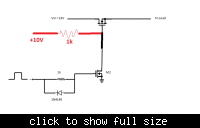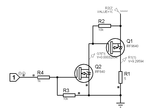pona
Junior Member level 2

The control logic in fig1 generates a high(10v) or low(0v) signal to supply the gate of M2 to turn it off or on which will then turn M1 on or off. The mosfet M2 alone works fine with circuit shown in fig 2 but when I connect it with M1, M1 doesn’t turn on or off. What can be the problem? Do I need a driver circuit for M1?






